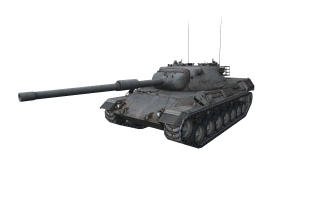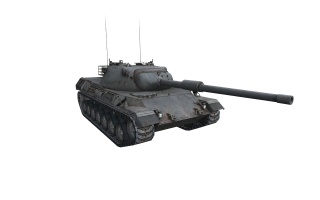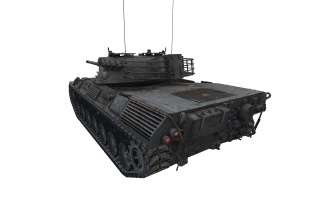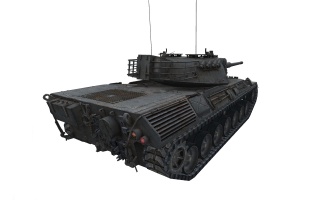Leopard 1
| |
This article requires additional modification. The design and/or content of this article do not conform to wiki standards.
|
Leopard 1
Mouse over "
[Client Values; Actual values in
| 6,100,000 |
| 1850370 HP Hit Points |
| 40/4221.05/42 t Weight Limit |
- Commander (Radio Operator)
- Gunner
- Driver
- Loader
| 830830 hp Engine Power |
| 70/23 km/h Speed Limit |
| 5050 deg/s Traverse |
| 20.7539.43 hp/t Power/Wt Ratio |
| YesYes Pivot |
| // mm Hull Armor |
| 52/60/6052/60/60 mm Turret Armor |
APCR/APCR/HE
APCR/APCR/HE Shells |
1290/4800/930
1290/4800/930 Shell Cost |
| 420/420/510420/420/510 HP Damage |
| 278/323/105278/323/105 mm Penetration |
|
6.45 r/m ▲
6.45 r/m Standard Gun ▲ Rate of Fire Standard Gun |
|
2709 ▲
Standard Gun
▼
Standard Gun
▲
2709 Standard Gun ▲
Standard Gun
▼
Standard Gun
▲ Damage Per Minute Standard Gun |
|
0.29 m ▲
0.29 m With 50% Crew: 0.359 m ▲ Accuracy With 50% Crew: 0.359 m |
| 1.7 s 1.7 s Aim time |
| 4040 deg/s Turret Traverse |
| 360° Gun Arc |
| -9°/+20°-9°/+20° Elevation Arc |
| 6060 rounds Ammo Capacity |
| 1010 % Chance of Fire |
| 410 m 410 m View Range |
| 750 m 750 m Signal Range |
X
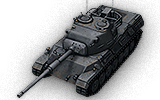
6100000
The Leopard 1 is a German tier 10 medium tank.
Main battle tank of the Federal Republic of Germany. Development was started in 1956. The first prototypes were built in 1965 at the Krauss-Maffei factory. The Leopard 1 saw service in the armies of more than 10 countries.
Main battle tank of the Federal Republic of Germany. Development was started in 1956. The first prototypes were built in 1965 at the Krauss-Maffei factory. The Leopard 1 was in service in more than 10 countries.
The Leopard 1 is the final advancement of medium tank tactics; capable of even firing on the move with little reticle bloom with good chances of landing a hit, agility that rivaling the Bat Chatillon 25t, Excellent View Range and deadly gun with good depression and rate of fire, this tank is meant to never miss a shot, its so versatile that it can even take passive scout roles, sniper, flanker and assist and only on emergencies as a brawler.
Of course, as all tanks it has a downside, the armor is almost as weak as the Bat Chatillon 25t so even HE splashes will cripple it severely, so staying mobile is a key to this tank only standing still to shoot and moving right away, also, the ammunition Rack is stored in the front so it will get hit often if not careful.
The Leopard 1 marks the end of its German medium line.
Modules / Available Equipment and Consumables
Modules
| Tier | Gun | Penetration (mm) |
Damage (HP) |
Rate of fire (rounds/minute) |
Dispersion (m/100m) |
Aiming time (s) |
Weight (kg) |
Price (
| |
|---|---|---|---|---|---|---|---|---|---|
| X | 10,5 cm Bordkanone L7A3 | 278/323/105 | 420/420/510 | 6.45 | 0.29 | 1.7 | 1282 | 290000 |
| Tier | Engine | Engine Power (hp) |
Chance of Fire on Impact (%) |
Weight (kg) |
Price (
| |
|---|---|---|---|---|---|---|
| X | MTU MB 838 CaM 500A | 830 | 10 | 1700 | 95000 |
| Tier | Suspension | Load Limit (т) |
Traverse Speed (gr/sec) |
Rmin | Weight (kg) |
Price (
| |
|---|---|---|---|---|---|---|---|
| X | Leopard 1 | 42 | 50 | 0 | 10000 | 82500 |
Compatible Equipment
Compatible Consumables
Player Opinion
Pros and Cons
Pros:
- Nice speed and mobility, on par or slightly better than Bat Chatillon 25 t
- Accurate gun with decent ROF
- Decent camo for its size
- Good gun depression
- Very good view range. On par with the tier IX M46 Patton
Cons:
- Very weak armor, only slightly stronger than Bat Chatillon 25 t
- Modules are easily damaged: most notably the turret and the ammo rack
Performance
There are essentially two routes which you can take with the Leopard 1: the role of a scouting sniper or the role of a supporting flanker. WIth the relatively weak armor of the Leopard 1, you cannot expect to survive any artillery hits, the full brunt of an autoloading tank, or anything which requires you to lead a charge. Thus it is suggested to decide on what style fits your play. Using the Leopard 1 as a sniping scout, it is suggested to put on binoculars, coated optics, and whatever third piece of equipment you choose, to maximize its view range and choosing the camouflage skill on your crew members in order to get an excellent mobile sniper. While the gun accuracy is good while stationary (regardless of equipment), while moving, and if you so choose the flanking duties of a med, it is highly recommended to use a rammer, Vertical Stabilizers, and vents.
Suggested Equipment
Gallery
Historical Info
The design started as a collaborative project between Germany and France in the 1950s, but the partnership ended and the final design was ordered by the Bundeswehr, production starting in 1965. In total 6,485 Leopard tanks have been built, of which 4,744 were battle tanks and 1741 were utility and anti-aircraft variants, not including eighty prototypes and pre-series vehicles. The Leopard quickly became a standard of European forces, and eventually served as the main battle tank in over a dozen countries worldwide. Since 1990, the Leopard 1 has gradually been relegated to secondary roles in most armies. In the German Army, the Leopard 1 MBTs have been phased out in 2003 while Leopard 1 derived vehicles are still widely used. The Leopard 2 MBTs have taken over the MBT role. Leopard hulls have been re-used in a wide variety of roles.
Development history
The Leopard project started in November 1956 in order to develop a modern tank, the Standard-Panzer, to replace the Bundeswehr's American-built M47 and M48 Patton tanks, which, though just delivered to West Germany's recently reconstituted army, were rapidly growing outdated. On 25 July 1957 the detailed specifications were released; the new design needed to weigh no more than thirty metric tons, have a power-to-weight ratio of thirty horsepower per ton, be able to withstand hits by 20 mm rapid-fire guns on every side as well as operate in a battlefield contaminated with chemical weapons or radioactive fallout, the then-standard baseline for combat with the Warsaw Pact. In addition the main armament had to consist of a 105 mm caliber weapon (the new British L7A3 105 mm gun was selected), carrying at least as many rounds as current US tank designs. Mobility was the priority while firepower came second; armour was seen as less essential, as it was believed no real protection against hollow charge weapons was possible anyway.
France was very interested in the design as its own AMX 50 project had just failed. In June 1957, West Germany and the French Fourth Republic signed an agreement to develop a common tank, designated in German Europa-Panzer. Three German (Arbeitsgruppe A, B and C) and one French design team would be included in a competition, with each team producing two prototypes each. In September, 1958 Italy joined the development program. Several prototypes were entered for testing in 1960. Among the prototypes were Porsche's Model 734 from team A, sporting a cast turret and that of team B (Rheinmetall) whose cast turret was somewhat higher. Team C from Borgward, designing a very futuristic tank, failed to have a prototype ready in time..
Even before these first prototypes were finished, it had (in 1959) been decided that a second phase with improved designs would be started: Team A had to build 26 phase II Prototypes for testing, team B six. Only two tanks of the required six would actually be constructed by team B. The Porsche Prototype II was eventually selected as the winner of the contest in 1963; this did not come as a surprise: it had already been decided in 1961 to build a preseries of fifty vehicles based on this design; production of these was started that very year. This "0-series" was modified with a new cast turret and several hull changes to raise the rear deck to provide more room in the engine compartment, and move some of the radiators to the upper sides of the hull. Before mass production of the standard version started it was also decided to add an optical range-finding system for better long-range gunnery, which required the turret to be somewhat taller, and added "bumps" on either side of the turret to mount the optics for triangulation. In 1963 France and Germany had decided to each build their own tank; Germany continued with the Leopard, while France built the similar AMX-30. Production was set up at Krauss-Maffei of Munich from early 1964 onward, with deliveries of the first batch between September, 1965 and July, 1966. The Leopard was soon being purchased from Germany by a number of NATO members and other allies including in chronological order Belgium (1968), the Netherlands (1969), Norway (1970), Italy (1971), Denmark (1976), Australia (1976), Canada (1978), Turkey (1980) and Greece (1981). Germany has a strict export policy for military equipment; Greece, Spain and Chile, while still dictatorships, purchased the French AMX-30.
Leopard 1A1
After the first batch was delivered the next three batches were the Leopard 1A1 model, which included a new gun stabilization system from Cadillac-Gage, allowing the tank to fire effectively on the move. The 1A1 also added the now-famous "skirts" along the sides to protect the upper tracks, and a new thermal jacket on the gun barrel to control heating. A less important change was to use rectangular rubber blocks fastened to the treads with a single pin instead of the earlier two-pin "shaped" versions. The rubber blocks could be easily replaced with metal X-shaped crampons for movement on ice and snow in the winter. Between 1974 and 1977 all of the machines in the first four batches were brought to the same Leopard 1A1A1 standard, and given additional turret armor developed by Blohm & Voss. A further upgrade in the 1980s added leftover image-intensifier night sights which were being handed down from the Leopard 2 as they were themselves upgraded. The PZB 200 image intensification system was mounted in a large box on the upper right of the gun, creating the Leopard 1A1A2. A further upgrade with SEM80/90 all-digital radios created the Leopard 1A1A3.
Leopard 1A2
The first 232 tanks of the fifth production batch was delivered as the Leopard 1A2 between 1972 and 1974. The A2 included a heavier and better armored turret, and therefore did not receive the B&V armor add-ons as did the earlier machines. They did receive the other upgrades however; the Leopard 1A2A1 received the PZB 200, the Leopard 1A2A2 received digital radios, and the Leopard 1A2A3 got both.
Leopard 1A3
The next 110 vehicles in the fifth batch were fitted with a new welded turret, which was equipped with a new armour consisting of two spaced steel plates with a plastic filling between them, and a wedge-shaped gun mantlet, creating the Leopard 1A3. Although the level of armor area density was equivalent to the A2's new welded version, the internal volume was increased by 1.2 m³ and the effective protection level was increased by half. The improved TRP 2A independent sight was installed for the commander. Upgrades were identical to the 1A2 models, the Leopard 1A3A1 with the night sights, Leopard 1A3A2 with the new radios, and the Leopard 1A3A3 with both.
Leopard 1A4
The Leopard 1A4 formed the sixth batch of 250 vehicles, delivery starting in 1974. The 1A4 was externally similar to the 1A3, but included a new computerized fire control system and the new EMES 12A1 sighting system to aim it. In addition the commander was provided with his own independent night sighting system, the PERI R12. The new equipment used up space and the ammunition load was reduced to 55 rounds, of which 42 were stored in the magazine to the left of the driver.
Leopard 1A5
In 1980 a research program was undertaken to study further improvements to the Leopard 1, providing it with a completely modern fire control system and fully effective night/bad-weather vision system. This was going to require even more room than the larger turret from the 1A3/1A4 models, so the decision was made to base the upgrades on the earlier models which were no longer competitive. The resulting Leopard 1A5 was based on 1225 vehicles of the Leopard 1A1A1 model. The turrets were again modified for the 1A5, with a larger section at the back, both in order to store all of the new equipment, as well as to move more of the ammunition into the rear turret, as opposed to the left side of the driver where it had traditionally been stored. The storage locker extended the turret almost to the rear of the tank when the gun was facing forward. The new turret was also able to mount the newer 120 mm gun from the Leopard 2 if desired, although this option has not been used. After trials the Krupp-Atlas Elektronik EMES 18 fire control system was selected in December 1983, developed from the EMES 15 used on the Leopard 2. The EMES 18 included two new sights on to the top of the turret, and no longer required the "bumps" as did the earlier optical systems. A crucial part of the upgrade was the introduction of more effective ammunition, including new APFSDS rounds. The Leopard tank could also be fitted with bolt-on lexan armour panels, which have increased the effectiveness of the armour. These "modified" tanks have proved themselves in the field. The first modified vehicle was delivered in early 1987. Since then almost all users of the Leopard 1 have also applied similar changes to their own vehicles, and in most ways the 1A5 can be considered the "standard" Leopard 1 today.
Leopard 1A6
A single 1A1A1 was also modified with additional armor on the turret and had the 120 mm gun as the Leopard 1A6. The project was ended in 1987, as the Leopard 2 was in widespread service at this point and the 1A5 offered a reasonable upgrade path for a fraction of the cost.


















